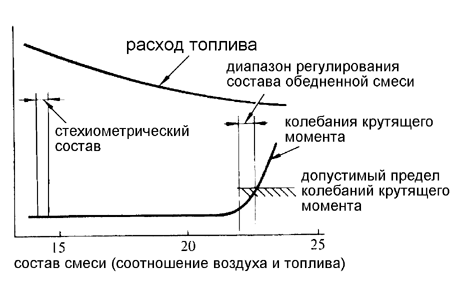|
Eugenio,77
mail@toyota-club.net
© Toyota-Club.Net
Nov 2004 - Aug 2005
The principles of LeanBurn system operation (Carina E (AT19#) for European market as an example). It should be noted that 4A-FE and 7A-FE LeanBurn engines for domestic and overseas markets are significant different.
4A-FE LB specs
| Engine |
4A-FE LeanBurn |
| Type |
R4 - inline 4 cylinder |
| Valvetrain |
DOHC 16V, belt drive |
| Displacement |
1587 cm3 |
| Bore |
81.0 mm |
| Stroke |
77.0 mm |
| Compression ratio |
9.5 |
| Max power output |
105 hp / 5600 rpm |
| Max torque |
139 Nm / 4400 rpm |
| Minimal RON |
90 |
| Motor oil |
API SG / SH or above |
|
Implementation of Lean Burn technology reduced maximum power output by 8% and maximum torque by 4%. Fuel consumption decreased by 3% (at highway) or 11% (in the city). Thus, there was no sense of innovations, especially in view of higher complexity and reduced reliability. |
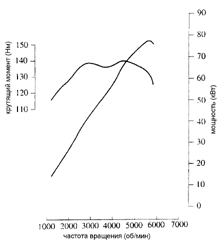
4A-FE LB full-load curve |
Design
|
Notable distinctions of 4A-FE LB are in the cylinder head design. There are projections at four of eight intake ports, forming the air turbulence in cylinders.
The fuel injectors are mounted directly in the cylinder head and fuel is injected close to the intake valves. The injection is carried out by each injector in turn ("sequential").
In the combustion chamber of the cylinder 1 the combustion pressure sensor (CPS) is installed.
|
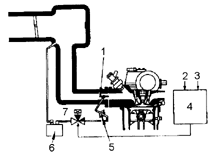 |
1 - IACV valve, 2 - from throttle position sensor, 3 - from crankshaft position sensor, 4 - ECU, 5 - actuator, 6 - vacuum tank.
|
|
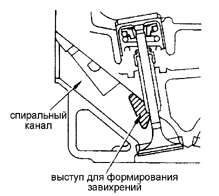
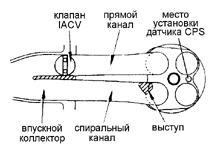 |
|
Most LB engines at second half of 1990s was equipped with DIS-2 (Direct Ignition System), with two ignition coils.
Also the special spark plugs was used - with a platinum-coated electrodes (for example, NGK BKR6EP13), iridium electrodes (IFR6A11) or double electrodes (BKR6EKB11).
At European LeanBurn engines a new type of oxygen sensor was installed (Lean Mixture Sensor 89463-), much more expensive beside to the traditional sensor and without non-genuine counterparts. At Japanese LeanBurn conventional oxygen sensor applied (89465).
Between the intake manifold and the cylinder head the set of valves with pneumatic control was installed (IACV - intake air control valve). Flaps are driven by vacuum actuator, via vacuum switching valve by signal if engine control module depending on the throttle opening angle and engine speed.
When the valve is closed, air flows through one of the ports, creating a swirl in cylinder. It contributes to better fuel evaporation and mixture turbulence, allows to lean mixture combustion.
Vacuum tank with built-in check valve supplies vacuum to the actuator and, accordingly, provides the valve closed state even with low vacuum in the manifold.
When driving in LeanBurn mode, the "Econo" indicator light up at combination meter. Indicator should be extinguished (for Euro-versions) in the following cases:
- acceleration or driving with high load
- the vehicle is stationary at idle
- before the engine warmed up
- AT range L or 2 (except braking)
- "O/D OFF" mode ON
|
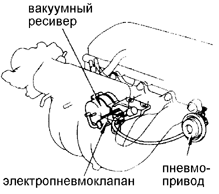
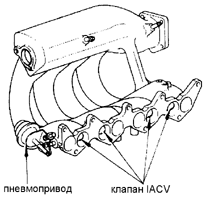
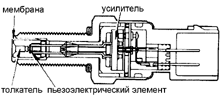
CPS sensor
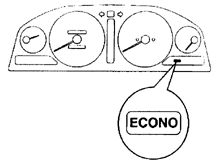 |
Operation
|
Fuel supply is performed in two modes - the stoichiometric (S) and the lean combustion mode (LB) depending on driving conditions.
1. Lean combustion mode (LB).
The combustion pressure sensor in cylinder 1 allows to control the stability of the engine running at LB mode, keeping the torque deviation within acceptable limits. Since CPS is installed in only one cylinder, the control is carried out by the crankshaft position sensor within one engine cycle. Operating conditions for other cylinders are supposed identical with cylinder 1.
2. Low to medium load operation
VSV is OFF and the vacuum from tank is applied to actuator via VSV, IACV flaps are closed.
Air passes through the "helical" port, forming a vortex in the cylinder. At the same time, some air passes through the bypass hole in "straight" port. It allows to improve the evaporation of the fuel and use lean mixture.
3. High load operation
At high load ECU turned VSV ON and air is supplied to the actuator. As a result, the both intake ports are opened, the intake resistance is reduced and power output is increased. |
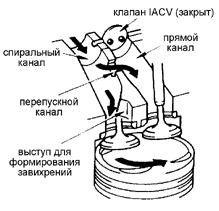
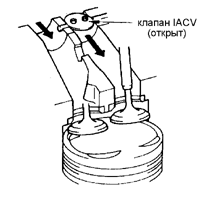 |
|
Более 2000 руководств
по ремонту и техническому обслуживанию
автомобилей различных марок
|
 |
|
 |
|
|
|












